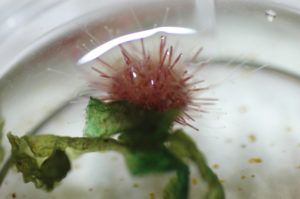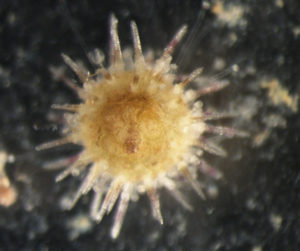Nutrition a key factor in initiating successful settlement of larval metamorphosis and eventual competent juveniles

The increased exploitation of worldwide fisheries to meet the demand for roe has resulted in declining sea urchin populations in many countries, yet fishing pressure on wild populations of sea urchins remains high. At current harvest rates, no sea urchin fishery is considered sustainable.
The aquaculture of sea urchins has the potential to supply high-quality roe, relieve fishing pressure on natural populations, provide seedstock to replenish wild populations and contribute animals for biomedical and ecotoxicological research and education. Land-based culture systems are currently being developed for several commercially important sea urchin species.
For the commercial production of sea urchins to be successful, animal husbandry technology must be developed for a predictable, cost-effective supply of quality seedstock of 5- to 10-mm-diameter juveniles for stocking the production phase. However, zygote to seedstock culture is a difficult task considered by some to be largely art.
Metamorphosis critical
Sea urchins begin life as free-swimming planktonic larvae and undergo a dramatic metamorphosis to become benthic grazers. This metamorphosis has presented a significant challenge for the production of sea urchin seedstock.
After metamorphosis, morphological structures associated with feeding and digestion are altered. The full extent of these changes at the physiological level are currently not known. In addition, little is known about nutritional requirements during this critical point in development. Yet nutrition appears to be a key factor in initiating successful settlement of larval metamorphosis and eventual competent juveniles. Greater understanding of nutritional requirements can increase survival and growth rates and ultimately produce sea urchins with marketable roe.
Understanding life history

Successful culture of sea urchins requires an understanding of all life stages, which historically have been divided into basic stages based on evolving morphology. Each stage has its own unique requirements for growth and survival.
In work funded by the NOAA National Marine Aquaculture Initiative and Mississippi-Alabama Sea Grant Consortium, the authors have defined life history stages for Lytechinus variegatus based on the feeding and/or nutritional requirements of the developing urchins. These include nonfeeding embryo, free-swimming planktonic larva feeding on unicellular algae, newly metamorphosed urchin feeding on benthic diatoms, juvenile urchin feeding on a mixed-taxa biofilm and small urchin that readily consumes formulated feeds.
After fertilization of shed gametes, the sea urchin life cycle begins with a nonfeeding embryo that must rely on maternal nutrients stored in the egg. The embryos develop a gut within 24 hours of fertilization, at which point the larvae are competent to feed on unicellular algae.
Although the nutritional requirements of L. variegatus larvae are not known, the authors have had excellent success using a mixture of Dunaliella tertiolecta, Rhodomonas salina and Isochrysis galbana algae. Larval growth and development have been well documented in L. variegatus. Nine to 12 days postfertilization, the rudiment tissues that will become the juvenile urchin develop in the larvae.
As the rudiment develops over several days, the larvae begin to settle on the bottom of the culture vessel. Settlement from the water column is encouraged by minimizing water exchanges during the later stages of larval development, allowing a thin biofilm of bacteria and/or diatoms to form on the surface of the culture vessels.
However, if the larvae are allowed to settle and collect in high densities on the bottom, they die, most likely due to oxygen depletion. To prevent mortality, the authors frequently transfer the newly settled larvae to nursery tanks with established substrates that enhance attachment and metamorphosis to juvenile urchins.
Larval feeds and feeding

After urchins metamorphose, they are no longer able to feed on unicellular algae in the water column. Successful transition of the larvae to juveniles represents one of the major challenges in sea urchin culture. Larvae often settle, but do not metamorphose. Other larvae metamorphose but do not feed. Newly metamorphosed urchins that do not feed or that feed on nutrient-poor diets develop fissures between the sutures of the calcified plates of their shells and die within two weeks.
The authors have identified a benthic diatom (Amphora helenensis) that enhances larval settlement and metamorphosis and is readily consumed by the newly metamorphosed urchins. This diatom is easily cultured in the laboratory. Newly metamorphosed urchins begin feeding within 24 hours, and the first fecal pellets are produced within 48 hours.
Interestingly, the diatom valves are clearly visible in the fecal pellets and appear to be fully intact. The authors hypothesize that the urchins may utilize the mucus coating surrounding the diatoms. This coating is rich in bacteria that may play a role in establishing the microbial gut flora of the juveniles. Without the proper flora, the gut may not mature properly and it may be difficult or impossible for juveniles to extract the necessary nutrients from their diets.
The urchins feed and grow on the diatoms until they reach 1.0-1.5 mm in diameter. This size marks the second major challenge in sea urchin culture. If the urchins continue to feed only on diatoms, growth rates decline and mortality increases. Whether this growth and survival limitation represents a quantitative or qualitative nutrient deficiency is not known.
To sustain urchins through this critical period, the authors have cultured a mixed-taxa biofilm obtained from seagrasses located at the site of natural populations of urchins. Epibionts scraped from the blades of the seagrass (Thalassia testudinum) were cultured in glass jars containing artificial seawater with F2 media.
After approximately four weeks, a thick biofilm composed of green filamentous algae, red algae and diatoms was established on the walls of the culture containers. The biofilm was harvested and fed to the sea urchins, which readily consumed and grew on it with over 95 percent survival. Urchins maintained on the biofilm diet attained diameters of 18 to 20 mm over a 14- to 18-week time period. However, recent applications of feeds formulated for juvenile urchins have resulted in growth rates significantly higher than those obtained with natural diets.
Perspectives
The need for high-quality seawater has generally limited larval culture to facilities with access to natural seawater in coastal areas. However, the authors currently culture larvae and juveniles in 100 percent synthetic seawater systems.
In addition, they are developing spawning techniques that allow the identification and enhancement of broodstock. Spawning urchins with 0.1-mm acetylcholine results in less than 1 percent mortality of broodstock, allowing the researchers to maintain them for future spawns. Broodstock maintained on formulated diets have been respawned after only eight weeks, allowing the authors to produce gametes year round.
(Editor’s Note: This article was originally published in the September/October 2008 print edition of the Global Aquaculture Advocate.)
Now that you've finished reading the article ...
… we hope you’ll consider supporting our mission to document the evolution of the global aquaculture industry and share our vast network of contributors’ expansive knowledge every week.
By becoming a Global Seafood Alliance member, you’re ensuring that all of the pre-competitive work we do through member benefits, resources and events can continue. Individual membership costs just $50 a year. GSA individual and corporate members receive complimentary access to a series of GOAL virtual events beginning in April. Join now.
Not a GSA member? Join us.
Authors
-
M.L. Powell, Ph.D.
Department of Biology
University of Alabama at Birmingham
Birmingham, Alabama 35294-1170 USA -
S.A. Watts, Ph.D.
Department of Biology
University of Alabama at Birmingham
Birmingham, Alabama 35294-1170 USA -
A.L. Lawrence, Ph.D.
Texas Agrilife Research
Texas A & M System
College Station, Texas, USA
Tagged With
Related Posts

Health & Welfare
Aquaculture could enhance Mediterranean Sea urchin fishery
Although researchers in several countries are working to enhance sea urchin fisheries or commercial production, the development of a major commercial industry has been restrained by the lack of cost-effective production technology.

Aquafeeds
Aquaculture Exchange: Giovanni Turchini, Deakin University, part 1
One of the world’s leading fish nutrition experts talks about how aquaculture can learn to survive, and even thrive without depending on fishmeal and fish oil. It’ll take a lot of innovation, but Giovanni Turchini is confident that the industry is on the right path.

Aquafeeds
Aquaculture Exchange: Giovanni Turchini, Deakin University, part 2
In the second part of our interview with the associate head of research at the School of Life and Environmental Sciences at Deakin University (Australia) he discusses the various alternative sources of omega-3 fatty acids coming on to the market and why research is crucial to advancing aquaculture.

Responsibility
Can ranching ‘zombie urchins’ boost uni, save kelp forests?
With Norwegian knowledge and a partnership with Mitsubishi, Urchinomics aims to turn worthless empty urchins into valuable seafood while restoring kelp forests and creating jobs.


